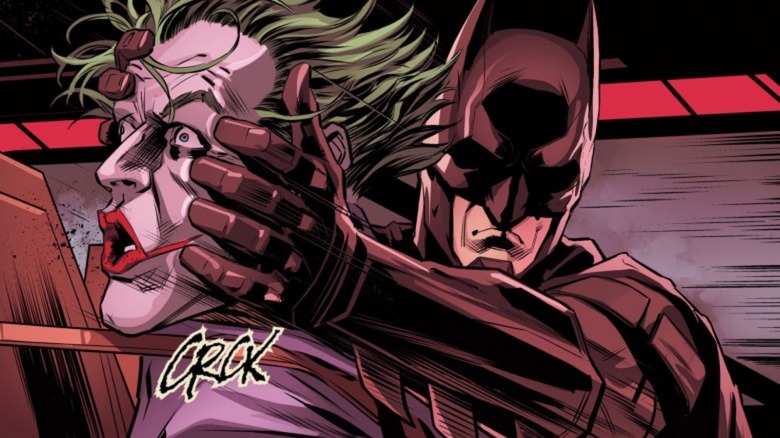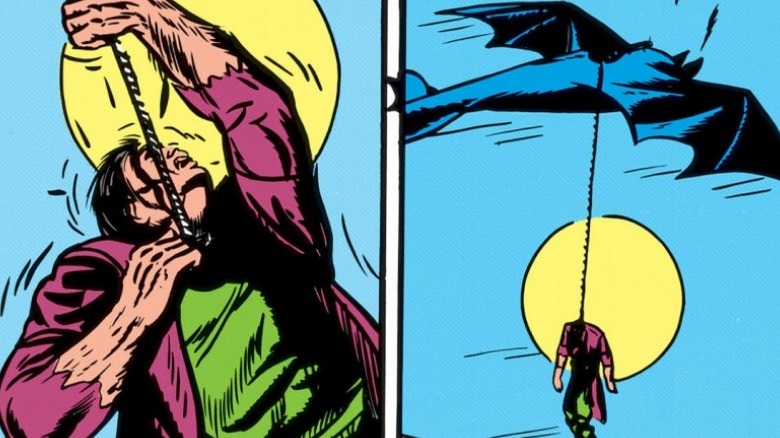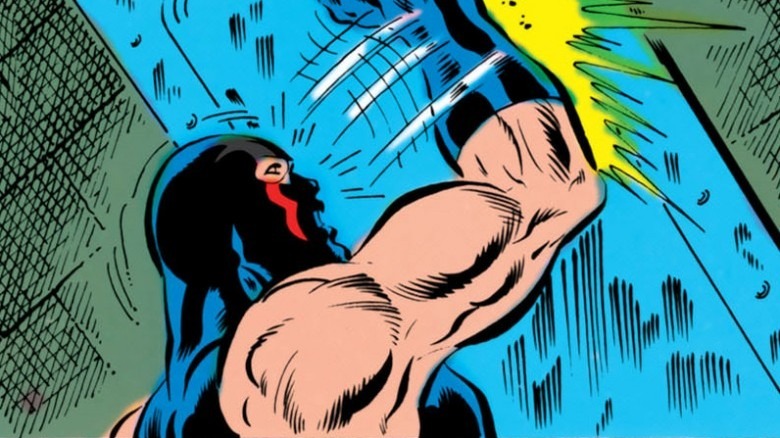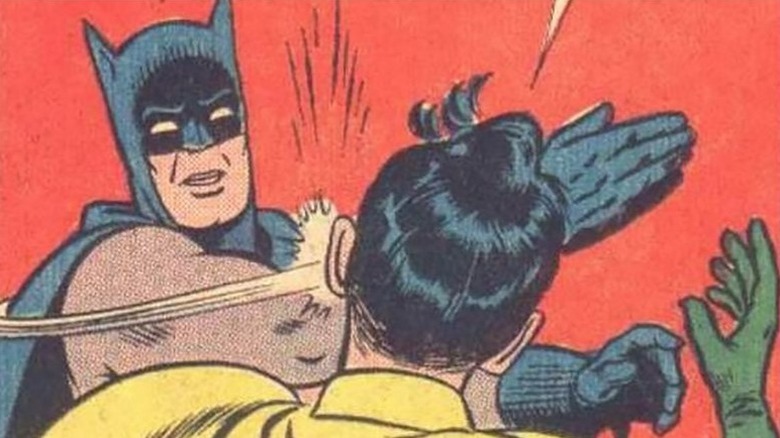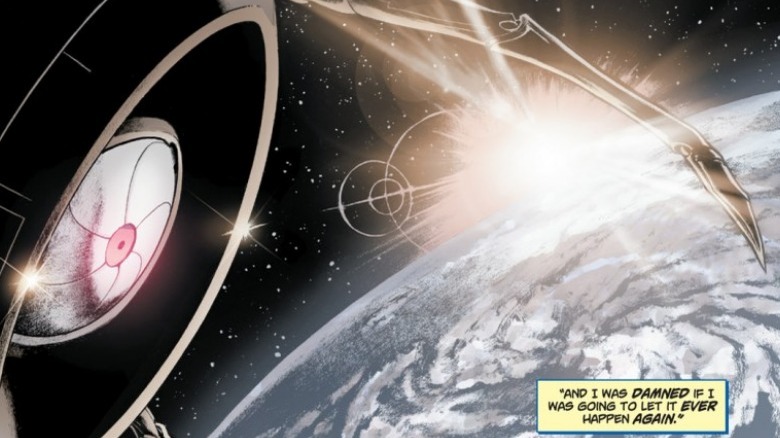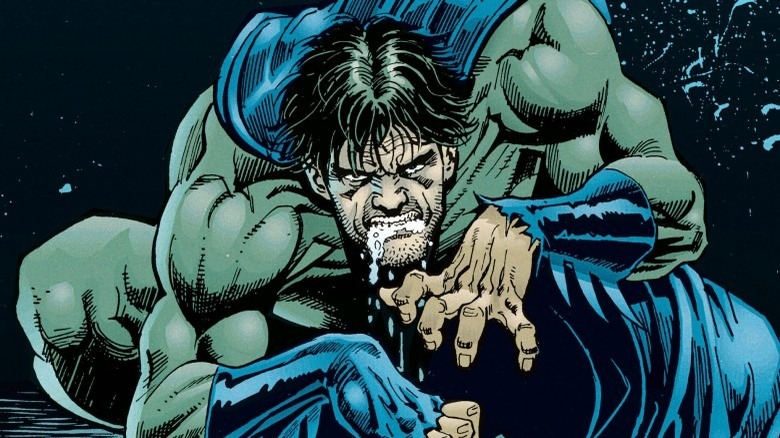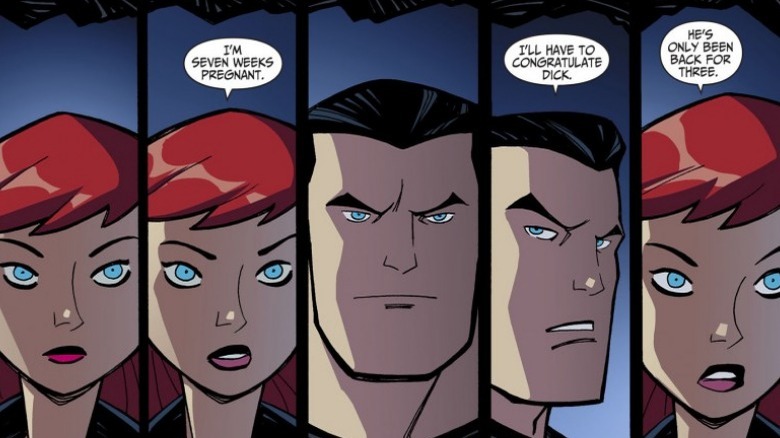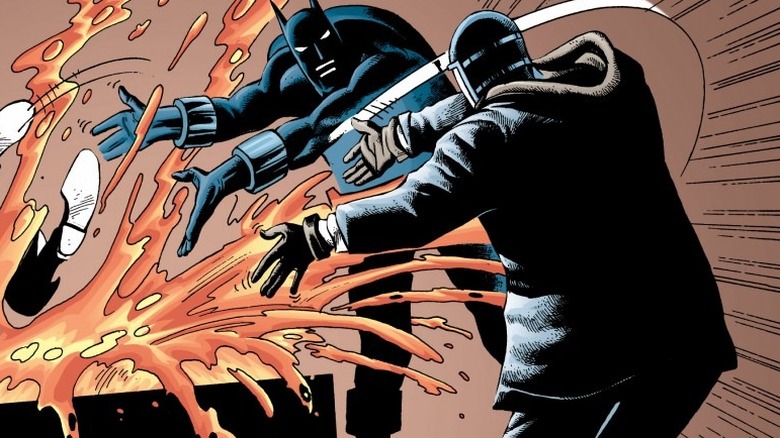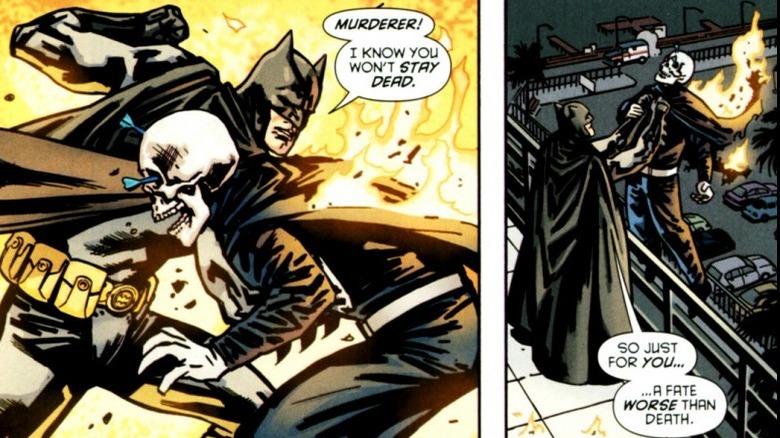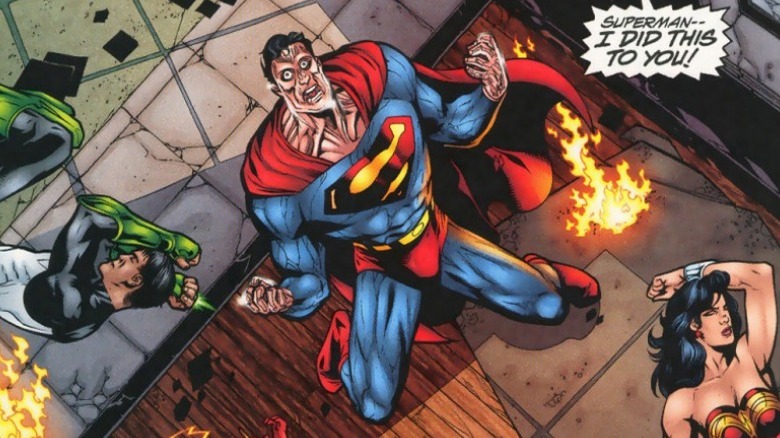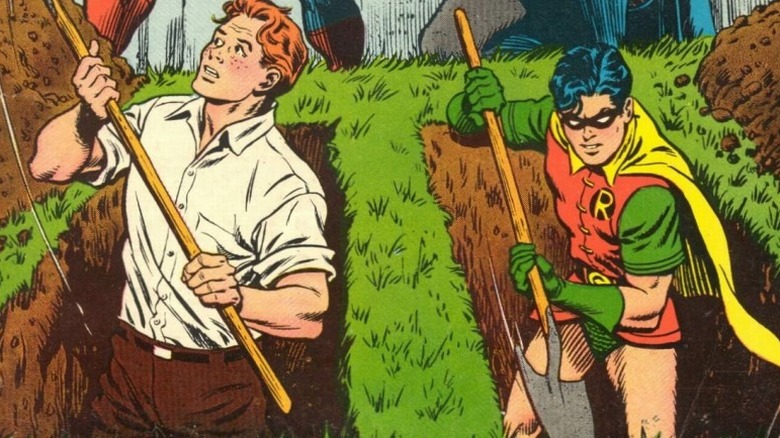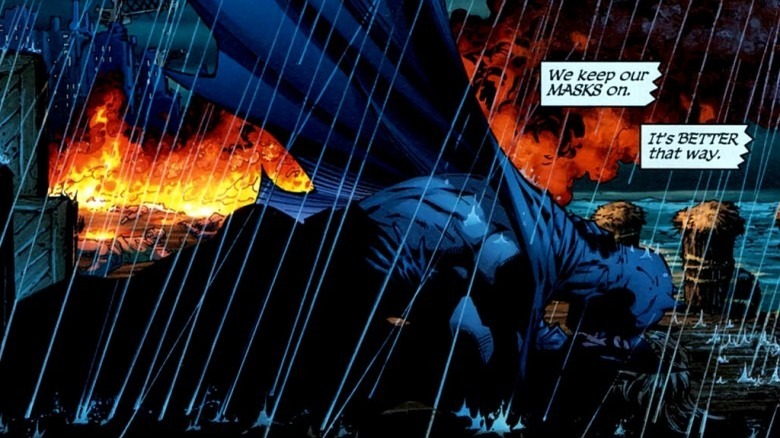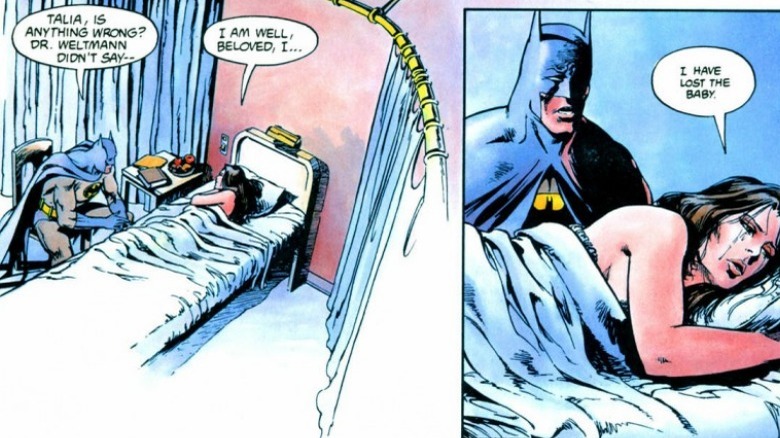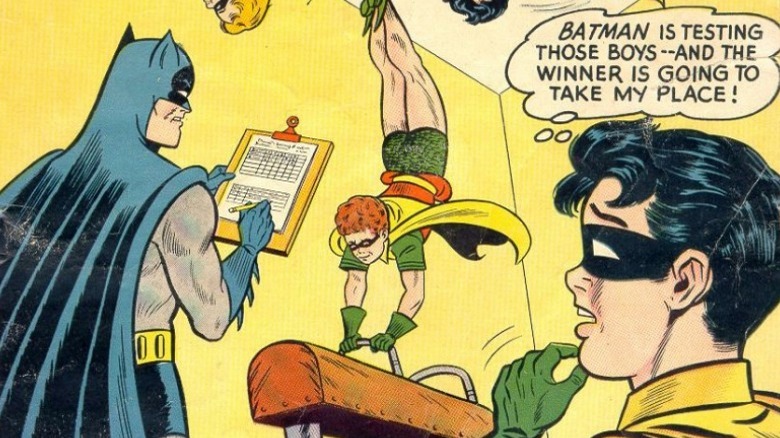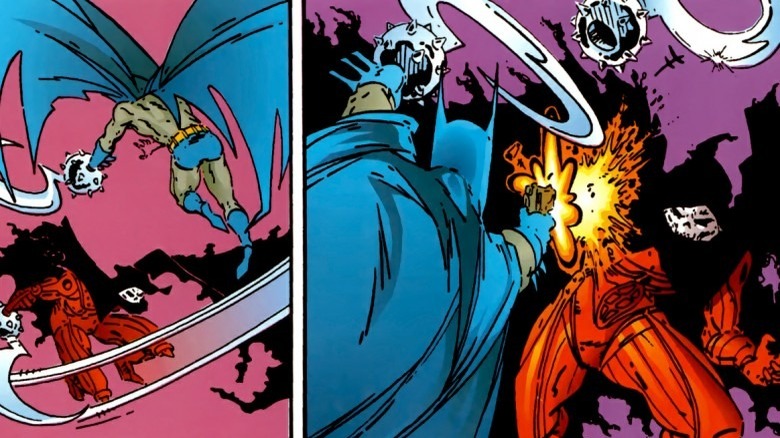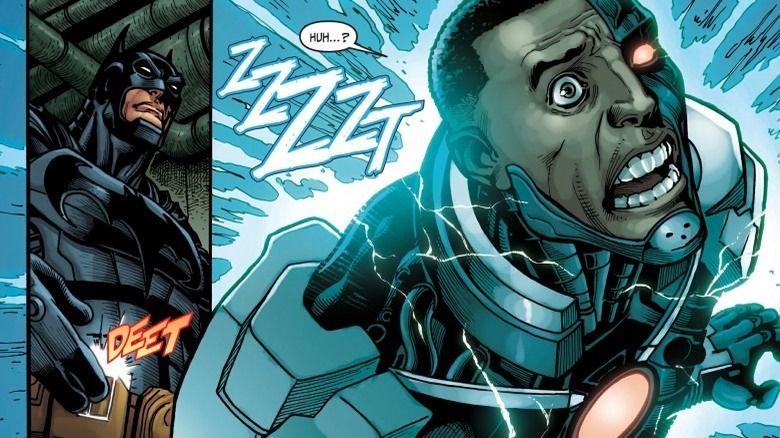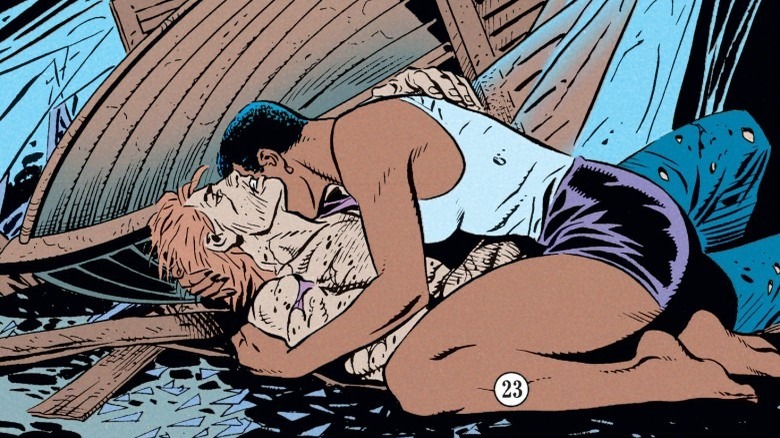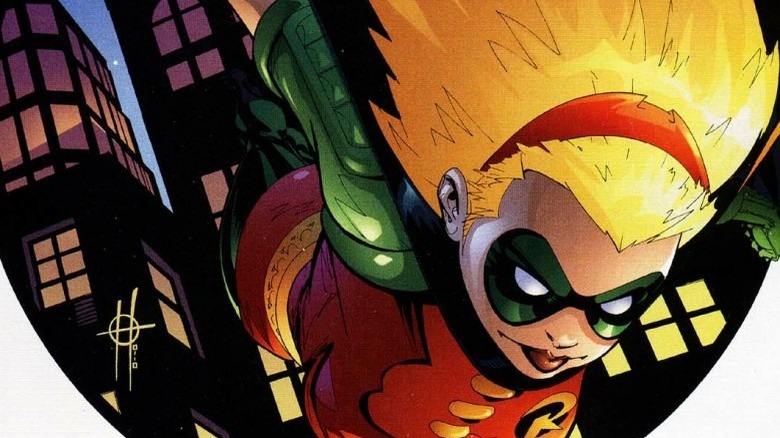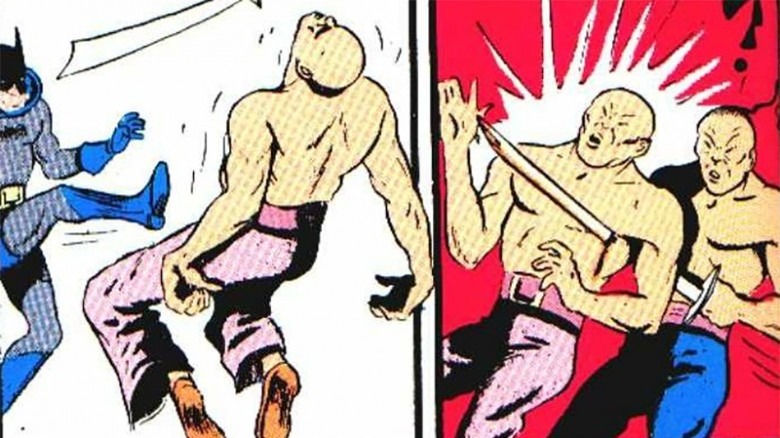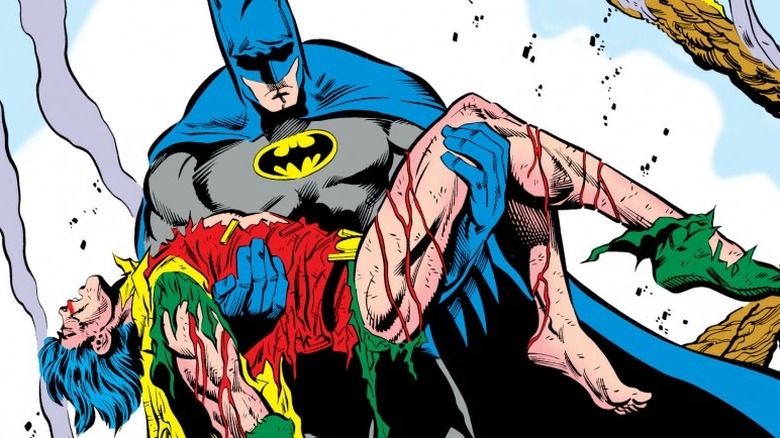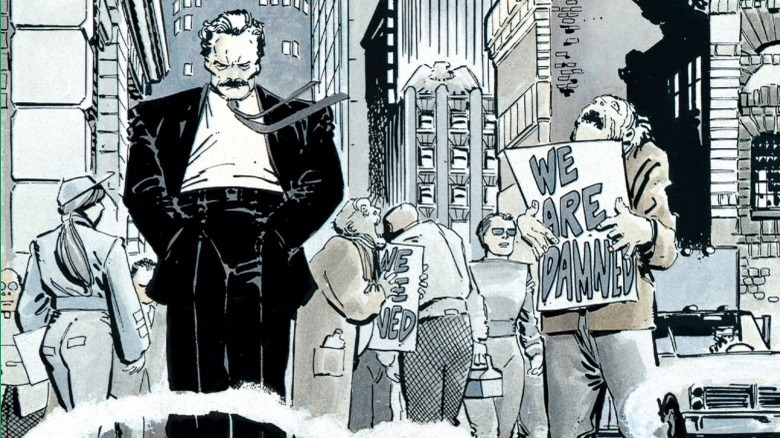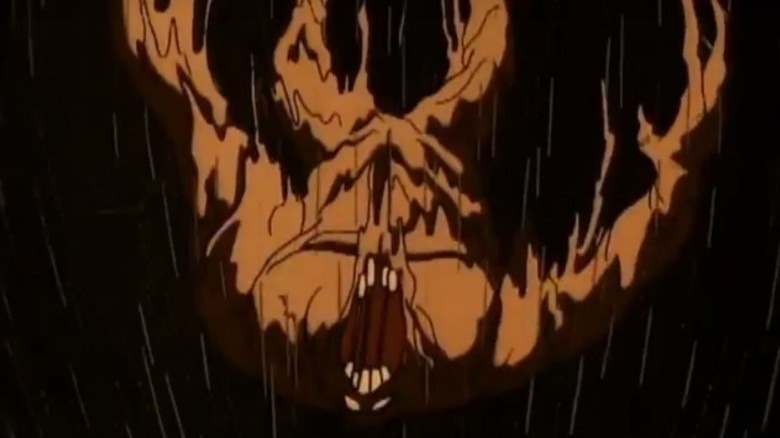The Most Terrible Things Batman Has Ever Done
Let's face it: for all the good he does, nobody is ever going to call Batman well-adjusted. He dresses up like a rodent and fights crime. He lives in an underground cave with an old man and a gaggle of children. He picks fights with Superman. Oh, and he's got a serious ego problem, too: everything has to be a bat-mobile, a bat-plane, or a bat-signal. Even his dog is a bat-hound—and not, say, just a regular dog.
Still, there's a difference between charmingly eccentric and outright crazy, and every now and then, Batman crosses the line. Sure, we all slip up now and then—but most of us haven't invested millions of dollars assembling a cutting-edge armory, and we didn't spend years forging our bodies into a lethal weapon. Batman did, so when he goes bad, he goes really bad.
Need proof? Read on.
He hanged a guy from the Batplane and left the corpse hanging there
The Batman who debuted in Detective Comics #27 wasn't exactly the honorable hero we've all come to know and love. Oh, sure, his costume looked pretty much the same, purple gloves aside, but his sense of morality borrowed a lot less from his Kryptonian counterpart and more from 1930s pulp heroes like the Shadow. In other words, Batman killed people, and he killed people often.
One particularly gruesome death occurred in Batman #1. In the story, Doctor Hugo Strange, one of Batman's earliest villains, breaks out of prison and injects some "escaped lunatics" with a special drug, transforming them into 15-foot powerhouses. Thanks to their size, the gang of monsters is essentially bulletproof, and Batman has to resort to extreme measures to take them down.
After shoving Doctor Strange out a window and knocking him onto the rocks below, Batman boards the Batplane and mows down the monsters' truck with a machine gun. Next, Batman dispatches one of the survivors by throwing a rope around his neck and flying high into the air, strangling the man to death. That's bad enough, but Batman's cavalier attitude towards the whole episode is particularly chilling: as he speeds away, the crook's lifeless body still dangling from the Batplane, Batman quips, "He's probably better off this way."
He sealed a villain underground and left him to starve
As time passed, the Caped Crusader eventually ditched his gun and developed a sense of morals—but that doesn't mean that he doesn't occasionally have blood on his hands.
To wit: while the late-'80s villain the KGBeast has become a fan favorite thanks to his pun-tastic name and delightfully dated Cold War gimmick, his first appearance ends in one of Batman's all-time cruelest acts. In Batman #420, Batman chases KGBeast through Gotham City's sewers, ultimately herding the Beast into an empty room. When KGBeast sees that he's cornered, he turns and challenges Batman to a fight. Batman declines—"Why should I?" he asks—and then closes the door. But Batman doesn't just lock KGBeast inside the room—he also blocks the door with wooden planks, making it impossible to open, before leaving the Beast to fend for himself.
"Sometimes you have to break the rules," Batman says, justifying his actions. "I'm not in this business to protect the rules. I serve justice." It's just too bad that the rule that Batman is breaking is the one about, y'know, not killing people.
He erased Robin's memory and sent the Boy Wonder back to the orphanage
You could argue that adopting orphaned children, submitting them to rigorous and dangerous training exercises, and then sending them out to fight murderers and psychopaths is terrible all on its own—and let's face it, you wouldn't be wrong. And yet, that's hardly the worst thing about the way that Batman treats his various Robins. For example, in The World's Finest #153 (a so-called "imaginary story"), a young Bruce Wayne becomes convinced that Superboy killed his parents. Years later, as Batman, Bruce plots his revenge against the Last Son of Krypton—and when Robin protests, Batman takes some drastic measures.
First, Batman slaps the Boy Wonder in a panel that's so vicious it's become a meme all its own. Next, after Robin continues to stand up for Superman, Batman ties Robin to a chair and uses a hypnosis machine to erase all of Dick Grayson's memories. Finally, Batman drops Robin off at the local orphanage—off-panel, just to add to the indignity—and returns to his vengeful crusade.
Of course, Superboy didn't kill the elder Wayne. Lex Luthor did. At the end of the story, Lex confesses to the murder, claiming that he was trying to steal Thomas Wayne's anti-Kryptonite formula when things got out of hand. A guilt-stricken Batman sacrifices his life to save Superman and dies in Superman's arms—but nobody tells Robin, who presumably languishes in the orphanage until he's old enough to live on his own.
He created a satellite to spy on his friends
Batman isn't the only hero to play fast and loose with other people's memories. In DC Comics' Identity Crisis, Zatanna and a handful of other Justice Leaguers decide to rehabilitate some of the world's worst supervillains by wiping their minds with magic, changing their personalities and making them less dangerous. When Batman catches the rogue heroes in the act, they erase his memory, too.
Eventually, the Justice League comes clean, but despite his comrades' honesty, Batman isn't pleased. In response to his friends' betrayal, Batman builds a spy satellite called Brother I to monitor the Justice League. Predictably, this doesn't go well. Despite his technical prowess, the satellite's artificial intelligence isn't nearly secure as it should be, allowing Justice League International founder Maxwell Lord to take over Brother I and use it to progress his own villainous goals.
In The OMAC Project, Batman and Wonder Woman stop Maxwell Lord and Brother I, but not before Lord mind-controls Superman and forces Wonder Woman to snap Lord's neck, all on live television. This inspires the Golden Age Superman, Kal-L, and a few other survivors from Crisis on Infinite Earths to invade Earth, and kicks off the line-wide cross-over Infinite Crisis—an event that costs millions of people, including Superboy, their lives.
He became a drug addict—on purpose
What happens when Batman can't get the job done? He resorts to substance abuse, apparently. In Legends of the Dark Knight #16, a young girl drowns when Batman can't lift a boulder that traps her in a flooded tunnel. As a result, he decides he isn't strong enough, and when a few extra hours in the gym don't cut it, he starts taking steroids to enhance his strength.
The problem—other than the fact that drugs are a terrible idea—is that the medication that Batman is taking is actually Venom, the same substance that gives Bane his super-strength. Batman gets stronger—at one point, he throws a refrigerator through a brick wall like it's nothing—but he also develops a particularly nasty mean streak. The scientist providing Batman with Venom uses Batman's newfound addiction to his advantage, and it's not long before the good doctor tells Batman that he'll need to kill Jim Gordon if he wants any more pills.
Gordon lives, of course, and Alfred locks Batman in the Batcave for a month while Bruce detoxes. Eventually, Batman tracks down the scientist and his cohorts and shuts the operation down—no medication needed—and arrests him fair and square.
He slept with Batgirl when Nightwing was out of town
Not only is Barbara Gordon, also known as Batgirl, young enough to be Batman's daughter, but her on-again, off-again relationship with Dick Grayson, the first Robin, is one of DC Comics' longest-running romances. Batman knows this—he's world's greatest detective, remember?—and yet he decides to sleep with Babs anyway.
The animated series Batman Beyond featured cameos from many classic Batman characters, but Nightwing, Dick's adult alter-ego, never appeared. Batman Beyond 2.0 #28 explains why. While Nightwing is fighting crime in Blüdhaven, Batman and Barbara have an affair, and Batgirl ends up pregnant. Barbara asks Bruce not to tell Dick, but Bruce, ostensibly out of concern for his friend, comes clean a few days later. Dick doesn't take the news particularly well, and the two former allies come to blows.
Even worse, while all of this is going on, Barbara takes to the streets and fights off a mugger. She wins, but Barbara's victory comes at a cost: crime-fighting puts too much stress on Babs' body, and while Bruce and Dick punch it out, Barbara miscarries in the middle of the street.
He brought the Joker back from the dead
Just because Batman does a terrible thing doesn't mean he likes it. In Legends of the Dark Knight #145, Batman finds his arch-nemesis, the Joker, bleeding to death in one of Ra's al Ghul's secret lairs. When Alfred calls for a celebration, Batman quickly explains that things aren't quite that simple: the Joker is the only person who knows what Ra's al Ghul is up to, and if Batman is going to stop the League of Assassins, he needs the Joker alive.
So, Batman dunks Joker in one of Ra's al Ghul's life-restoring Lazarus Pits, reviving the Clown Prince of Crime. It works, but there's a twist: while most people emerge from the Lazarus Pit in a state of "advanced psychosis," the Joker resurfaces of it completely sane. Plagued by guilt over his past misdeeds, the Joker helps Batman track down Ra's, and it isn't long before Ra's' plan is foiled for good.
Unfortunately, the Joker's rehabilitation doesn't last. As the Lazarus Pit continues to work its magic, the Joker's insanity slowly returns, meaning that every murder he commits from that point forward is Batman's fault. Sure, Batman saved the world, but it's hard not to imagine that there could've been another solution. Remember, Batman is officially the world's greatest detective. If anyone can find Ra's al Ghul without the Joker's help, it would be him.
He condemned a man to solitary confinement for eternity
Lord Death Man, as the name implies, is literally death's master: he cannot die. Given that Batman doesn't usually kill, that shouldn't be a problem—most of the time, he simply locks his villains away in Arkham Asylum and prays they won't get out (they always do). And yet, for some reason, Batman decides to deal with Lord Death Man in a much more permanent manner: by locking the villain in a rocket and launching him towards the stars, where he'll spend the rest of time completely alone.
This all goes down in Batman Incorporated #2, an adventure that follows Batman, Catwoman, and a young man named Jiro Osamu as they avenge Mr. Unknown, a Japanese superhero. Ostensibly, the story is about Jiro becoming the new Mr. Unknown and joining Batman's international crimefighting force, but it's Lord Death Man's cruel fate that really stands out—especially in the comic's final panels, which show Bruce Wayne and Selina Kyle calmly sharing a drink while Lord Death Man's ship twinkles in the sky above, beginning its long journey towards absolutely nowhere.
He drafted detailed plans for taking out the Justice League
The Justice League has always known that Batman has trust issues—remember, this is a man who carries around a Kryptonite ring in order to protect himself from his best friend—but they didn't realize how far he was willing to go until it was almost too late. JLA's Tower of Babel arc shows what happens when a supervillain discovers Batman's plans for beating his Justice League teammates, and the results aren't pretty.
After the Injustice League (evil, alternate-dimension versions of the Earth's heroes) switches bodies with the Justice League, Batman decides to keep detailed files about every League member, including ways to bring them down. Unfortunately, those files fall into the hands of Ra's al Ghul, who promptly uses them in a bid to take over the world.
Under Ra's direction, Martian Manhunter's skin is transformed into magnesium, which bursts into flame when it comes into contact with the air around him. Aquaman receives a custom dose of the Scarecrow's fear gas, making him terrified of water, which he needs to survive. Wonder Woman is trapped in a computer simulation that contains an unstoppable opponent—the more she fights, the weaker she becomes. Hypnotic suggestion blinds Green Lantern, robbing him of the ability to control his power ring. Superman's skin turns translucent thanks to some Red Kryptonite, which kicks his solar receptors into overdrive, causing unimaginable pain. Plastic Man is shattered into pieces after being exposed to liquid nitrogen, and a custom-made bullet gives Flash seizures at the speed of light, completely paralyzing him.
Batman doesn't get off the hook, either. Ra's distracts him by stealing his parents' bodies, and once the League recovers, Batman has to answer to his friends. The other superheroes vote on whether or not Batman should still be part of the League, but before they can deliver the verdict, Batman leaves the Justice League Watchtower, effectively quitting the team.
He made Robin dig his own grave
DC's Silver Age covers are famous for putting superhero sidekicks into outlandishly cruel situations—there's an entire website devoted to Superman's "superdickery"—and World's Finest #195 has one of the best. As Superman and Batman look on, Jimmy Olsen and Robin dig two graves, and while Superman acknowledges that he has a "code against killing," a tommy gun-wielding Batman brags that he's willing to "do the job."
Batman really means it, too. Through a remarkably convoluted series of events, Batman ends up disguised as a crime boss named Karl Lukaz, but after a bump on the head Bruce starts to believe he really is the Mafia don. As Lukaz, Batman draws a gun and orders Jimmy and Robin to start digging, but snaps out of his funk after Robin gives a heartfelt plea to the man that he loves like a father.
Of course, this being the Silver Age, that's hardly the end of things. Soon, the real Lukaz arrives and tells Superman (who's undercover as a Mafia accomplice) to stop Batman and kill the two boys. Superman knocks out Batman, turns his heat vision on Robin and Jimmy, and gives Lukaz a glass case containing the two sidekicks' hearts. It's all a ruse, of course—Superman replaces Jimmy and Robin with wax statues and molds replica hearts from the wax remnants with his super-speed—but Lukaz's newfound trust in the Man of Steel gives the World's Finest team the time that they need to dismantle Lukaz's operation and put the criminal behind bars.
He's turned on by violence
Pretty much everything about Frank Miller and Jim Lee's Batman is summed up in a single panel of All-Star Batman & Robin, The Boy Wonder #2. After kidnapping Dick Grayson, whose parents were just killed, Robin asks Batman who he is. Batman replies, "Are you retarded or something? Who the hell do you think I am? I'm the goddamn Batman."
From that point on, it's clear that this isn't the brooding tactician fans have come to know and love. This Batman is a lunatic, a sadist, and a grade-A jerk. In All-Star Batman & Robin, Batman locks Dick in the Batcave without any food or water, telling the boy—who, once again, just watched his parents die—that Dick can hunt bats if he gets hungry. Batman steals Green Lantern's ring and nearly kills his fellow superhero with his fists. Miller's Batman doesn't just beat up criminals—he takes pride in causing them pain.
And yet, all of that pales in comparison to All-Star Batman & Robin, The Boy Wonder #7, which features a team-up between Batman and a ridiculously sexualized Black Canary. While taking on a horde of goons at the Gotham City docks, Batman launches an improvised Molotov Cocktail into the crowd, sending the wooden pier up in flames. Black Canary, watching from the shadows, is so turned on by Batman's ruthlessness that she's making out with Batman four panels later, and before long, the two of them are bumping uglies in full costume while the thugs burn to death in the background.
He abandoned his only child
For years, Mike W. Barr and Jerry Bingham's graphic novel Batman: Son of the Demon had a fairly loose connection to DC Comics' continuity, but Grant Morrison rescued the story from limbo when he borrowed elements from Son of the Demon to introduce Batman's son, Damian Wayne, in 2006's "Batman and Son" storyline. While Morrison tweaked Damian's history (in the updated edition, Damian is grown in an artificial womb, not born naturally), each version of the story shares a common element: in both, Batman is a deadbeat dad.
In Son of the Demon, Batman marries Talia al Ghul, the daughter of the League of Assassins' head honcho, Ra's al Ghul. Before long, Talia is pregnant—and, surprisingly, Batman is thrilled. Unfortunately, his happiness doesn't last. Batman almost dies protecting Talia from an assassin named Qayin, the same man who killed Talia's mother, and decides to retire from crimefighting in order to give his child the family he never had. In order to restore Batman's edge, Talia fakes a miscarriage, and the two lovebirds decide to annul their marriage before Batman returns to Gotham City.
Nine months later, Talia gives birth, but instead of keeping the baby for herself, she drops the child off at an orphanage, leaving only an ornate necklace—a gift from Batman to Talia during happier times—to prove his identity. Now, you could argue that Batman had no way of knowing that his child was alive, but we don't buy it: Batman's true superpower is his deductive reasoning, and he should've been able to see through Talia's ruse...if he really wanted to, that is.
He trained Robin's replacement—while Robin watched
If you haven't noticed, Batman and Robin have a... troubling relationship. It doesn't get better in Detective Comics #237, in which Batman—who is, for all intents and purposes, Dick Grayson's adopted father—tries to replace Robin with some other kids.
It all goes down after gunmen attack Batman and Bruce Wayne (actually a lifelike dummy controlled by Batman via ventriloquism) at a bridge-opening ceremony. During the commotion, "Bruce" takes a few bullets to the chest and falls into the river below, and when police can't find the body, Wayne is declared dead. As a result, Batman needs to find a new secret identity—but Dick, Bruce's official heir, can't come along, or he'll blow Batman's cover.
In his new identity, a cab driver named Barney Warren, Batman meets a few possible new Robins, but none of them have Dick's discipline, drive, or intelligence. Thankfully, Robin finds a way out. After the dummy washes ashore, Bruce and Robin visit Commissioner Gordon and explain that Bruce knew the gunmen were coming for him, and faked his death until Batman could put the gangsters behind bars. It's a flimsy excuse but it works, and with Bruce Wayne back, Batman promises Dick that he'll never be replaced as the Boy Wonder—at least, not until Jason Todd comes along...
He shot his fiancee's father
Don't date Batman. While Bruce Wayne's superpowered partners tend to end up okay—Catwoman, Talia al Ghul, and Wonder Woman all survived their relationships with the Bat—his civilian partners aren't quite as lucky. Just look at the sad story of Rachel Caspian, Batman's love interest in the four-part Year Two storyline and daughter of the Reaper, Gotham City's first masked crimefighter.
Bruce meets Rachel, a charity worker, through Leslie Thompkins, who runs a clinic for the poor in Gotham's slums. While they quickly fall in love, Rachel's father, Judson Caspian, returns to Gotham and picks up where he left off as the Reaper, slaughtering anyone who happens to be on the wrong side of the law. When Batman tries to stop Judson, the Dark Knight falls victim to the Reaper's firearms, and is beaten within an inch of his life.
The defeat forces Batman to take drastic measures. Bruce retrieves the gun that killed his parents and enlists the help of Gotham's underworld—including Joe Chill, the man who murdered Thomas and Martha Wayne—to take the Reaper down for good. But Batman has a secret plan: once the Reaper is out of the picture, he's going to kill Chill and retire. With the end of his crimefighting career in sight, Bruce proposes to Rachel, and then prepares for his final showdown with her father.
It doesn't go according to plan. The Reaper wipes out Batman's criminal allies, and murders Joe Chill before Batman can pull the trigger. Batman shoots the Reaper in the following battle, knocking off his mask and forcing him to the edge of an in-construction skyscraper. Judson reveals his true identity and gives Bruce his blessing to carry on the Reaper's work—as Judson says, "I didn't think you were a killer. I see now, I was wrong"—before falling off of the ledge to his death. Batman swears off guns forever, but it's too late: devastated, Rachel leaves Gotham City to become a nun, hoping to atone for her father's sins.
He infected Cyborg with malware
Injustice: Gods Among Us might take place in an alternate reality, but Batman was breaking rules long before the timeline split and Superman went rogue. In Injustice: Gods Among Us Year One #15, Superman and his cronies hack into Arkham Asylum with Cyborg's help and relocate Batman's rogues one by one to a secure, secret prison. Batman tells Cyborg to stop opening the prison doors, and when Cyborg refuses to comply, Batman activates a computer virus and shuts Cyborg down completely.
But how? As Cyborg notes, he upgrades his firewalls constantly, and Batman shouldn't be able to get through his latest security updates. And that's the thing—he didn't. Cyborg realizes that Batman uploaded the virus into Cyborg's system the very first time they met, back when Cyborg was still a teenage football star recovering from a traumatic injury, and has been waiting to use it ever since.
Even Killer Croc admits, "That's pretty evil," and it looks like a full-on Batman vs. Cyborg brawl is about to break out when Green Arrow, Harley Quinn, and an army of escaped mental patients intervene, forcing the dueling heroes to team up in order to survive.
He made his girlfriend go insane
Because of her involvement with Bruce Wayne, Rachel Dawes (played by Katie Holmes in Batman Begins and Maggie Gyllenhaal in The Dark Knight) ends up dying in a bomb attack as part of the Joker's plan to bring chaos to Gotham City. Compared to Shondra Kinsolving, however, Dawes got off easy. Rachel only lost her life. Shondra lost her mind.
Once upon a time, Shondra was a therapist who counted Jack Drake (father of Tim Drake, the third Robin) among her patients. After Bane breaks Batman's back in the '90s epic Knightfall, Bruce turns to Shondra for help. As Shondra cares for the broken superhero, the pair fall in love—and then Sondra's brother attacks.
Benedict Asp, Shondra's adopted sibling, uses a drug cocktail to hypnotize and kidnap Shondra and Bruce, then uses Shondra's psychic abilities—yes, apparently she has powers—to massacre a small village. In Legends of the Dark Knight #61, Shondra and Bruce fight back, but with Shondra still traumatized from the murder and Bruce stuck in a wheelchair, it doesn't go well. In the heat of battle, when everything looks like it's lost, Bruce asks Shondra to marry him, and that's just enough to snap Shondra back to her senses. Shondra kills Benedict and uses her powers to heal Batman's back, but sacrifices her sanity to do so, and as Bruce returns to Gotham and the spandex, Shondra's shipped off to a mental hospital, where she spends the rest of her days thinking she's still a small child.
He hired Robin's girlfriend just to make Robin jealous—and got her killed
In 2004, Tim Drake, the Robin at the time, hung up his cape after his father discovered his secret identity. In Robin #126, Stephanie Brown, Robin's longterm girlfriend and a vigilante herself, sews her own Robin costume and sneaks into the Batcave, hoping to get Tim's old gig. To her surprise, Batman hires her on the spot—but not because Stephanie's qualified for the position.
While discussing Stephanie's new position with Alfred, Batman admits that Stephanie "lacks the skills and talent" that she needs to succeed. When Alfred asks if the newest Robin is just "some scheme to lure Tim back," Batman walks away without answering the question. He doesn't need to—his silence says everything.
Stephanie does the best she can, but the deck is stacked against her from the very beginning, and her career as Robin ends just two issues later, when Batman fires her for disobeying orders. It gets worse, too. In order to earn back Batman's trust, Stephanie sets one of Bruce's top-secret agendas into motion, starting a gang war that's supposed to unite all of Gotham's criminals under the control of Matches Malone, one of Batman's aliases. It doesn't work, and violence consumes the city. For her mistakes, Stephanie is captured and killed by the Black Mask, one of Gotham's gang leaders, while an attack on Tim's school leaves a few of his fellow students dead.
In the gang war's aftermath, Tim realizes he can't shirk his duty to Gotham City and returns to duty as Robin. So, in a roundabout way, Batman's plan to bring Tim back into the fold actually worked—even if success came at a very, very high price.
He threw a guy onto another guy's sword because of racism
In the '40s, Batman wasn't the social justice crusader he is today. In fact, at times, he was flat-out prejudiced. He wasn't alone, of course—around the same time, Superman encouraged readers to "slap a J** with war bonds and stamps." Still, even by the standards of the time, Batman's blatant racism seems a little extreme, as seen in Detective Comics #35, when Batman gets tangled up with Hindu cultists and a Chinese crime boss.
Batman gets involved when an antiques collector named Weldon starts receiving death threats from the aforementioned cultists, and it's not long before thieves break into Weldon's house and steal a rare ruby idol. Batman traces the robbery back to Sin Fang, a fence for stolen goods, and is just about to recover the statue when Fang's Hindu soldiers attack. That's when things get ugly.
Batman doesn't usually kill (he's let the Joker off the hook for years), but he has very little regard for the lives of the Hindu soldiers, who are stereotypically shirtless, wear giant turbans, and wield scimitars. The swords are the real problem, of course—when one of cultists soldiers rushes Batman, the Dark Knight grabs the man's wrist and hurls him backwards, right into his partner's outstretched blade.
Even stranger, it turns out that both Fang and the cultists are actually white. Lennox, the explorer who stole the statue in the first place, faked his death and dressed up as Sin Fang in order to get the idol back from Weldon. He even hired "fake Hindus" to cover his tracks. After Lennox's confession, Batman keeps his murder streak going by clocking Lennox in the head with the idol, knocking him out the window and splattering him on the sidewalk below.
He let Robin die
It was going to happen sooner or later. You can't send children to fight psychopaths for over 40 years without something going wrong, and in the groundbreaking Batman arc A Death in the Family, Batman finally pays for years and years of child abuse.
Of course, as always, it's really Robin who gets the short end of the stick. In the story's biggest moment, Joker beats Jason Todd, the second Robin, with a crowbar, and then traps him inside a building with a ticking time bomb. The bomb goes off before Batman arrives, and Robin dies in the blast.
While that sounds like Robin's death is the Joker's fault (and, to be fair, the Clown Prince of Crime plays a major role in Jason's demise), it all comes down to Batman, who made mistakes with Jason from the very beginning. When Batman discovers that Jason's father was murdered by Two-Face, he keeps it a secret—and when Jason learns the truth, he's furious. From that moment on, Jason doesn't trust Batman, and so when Jason's birth mother is kidnapped by the Joker, he disobeys Batman's orders and goes after the supervillain on his own.
In the aftermath, Batman admits Jason was too young and impulsive to be Robin—but that didn't stop Bruce from putting him in a domino mask anyway. "I felt so adrift when I lost Dick Grayson as a partner," Batman laments. "I guess the truth is that I was lonely... didn't want to go it alone." And so, Batman hired Jason, and Robin lost his life—something that happened again in 2013, when an assassin killed the fourth Robin, Damian Wayne, and yet again in 2016, when Tim Drake sacrificed his life to save Gotham City.
He punked out when the going got tough
Batman needs Gotham City, and Gotham City needs Batman. Just look at what happens when he's not around. In Batman Beyond, Bruce Wayne hangs up the cape and cowl after years' worth of injuries catch up to him, letting Gotham fall into the hands of clown-themed street gangs called Jokerz. In The Dark Knight rises, a leg injury keeps Batman out of action, paving the way for Bane's hostile takeover.
And then there's The Dark Knight Returns, Frank Miller's infamously dark take on Batman's ultimate future. In the world of The Dark Knight Returns, Batman gives up after Jason Todd's death, and in his absence a gang called the Mutants transform Gotham City into a war-torn dystopia. Meanwhile, Superman transforms into a government stooge, Green Arrow loses his arm, and Harvey Dent completely succumbs to Two-Face. Even after Batman returns to action, things don't get much better. During The Dark Knight Returns, Russia launches a nuclear warhead at America, the Joker kills a room full of people on live television, and an electromagnetic pulse plunges the United States into chaos.
You know who could've stopped all of this from happening? Batman. Bruce Wayne dedicated his life to keeping Gotham City safe, and spent years protecting the city. It's hardly a surprise that Gotham came to rely on him, and as a result, suddenly disappearing isn't just irresponsible—it's, quite literally, the worst thing that Batman could possibly do.
He let Clayface melt away
While we're cataloging Batman's sins, let's add another one to the list: he's a big fat liar. At the beginning of the Batman: The Animated Series episode "Mudslide," Batman says he's willing to help Clayface get better, but he doesn't mean it. How do we know? Because, as the episode continues, the Dark Knight has a chance to cure the former actor, and instead, he shuts down the life-saving procedure and sends Clayface hurtling toward his apparent demise.
When "Mudslide" begins, the creature formerly known as Matt Hagen has shacked up with Stella Bates, a doctor who's fallen in love with Hagen (more specifically, one of the characters in Hagen's old movies) despite his ever-shifting visage. While Hagen's condition is getting worse—he can barely keep his monstrous Clayface look together, to say nothing of more complicated disguises—Bates thinks she's found a cure. All that Clayface needs to do is get inside Bruce Wayne's biomedical research facility, steal an isotope called Mp40, and...well, that's it.
So that's exactly what Clayface does. Nobody's hurt during the break-in, damage is minimal, and the isotope is the only thing that Clayface steals. The process works, too, and before long, Clayface is on the road to recovery. And yet Batman tracks Clayface down and stops the operation. There's no good reason for this petty act. Bruce Wayne owns the isotope, and it's been tainted anyway, so there's no property to recover. It was a victimless crime, and once again, the procedure is the only way to save Clayface's life. So when the rain mixes with Clayface's deteriorating body and washes him off the side of a cliff, Batman's anguished screams ring pretty hollow. You could've saved him, Bruce, and you chose not to. That's all on you.
